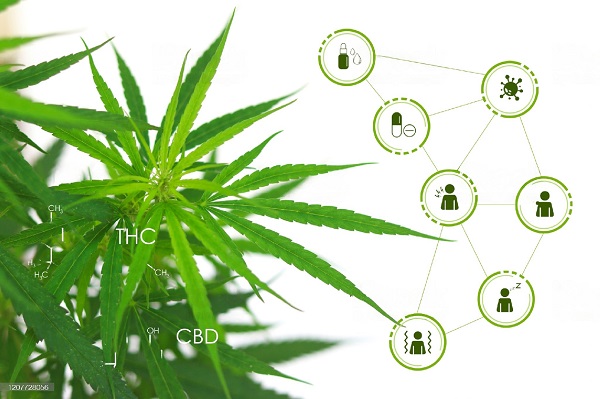The endocannabinoid system (ECS) is a complex cell-signaling system that plays a crucial role in regulating a wide range of physiological processes and maintaining homeostasis within the human body. Despite its significance, it was only discovered in the late 20th century and remains a relatively underexplored area in medical science. The ECS is fundamentally important in the context of medical cannabis, as the compounds found in cannabis interact directly with this system. This blog aims to provide a comprehensive understanding of the ECS and elucidate how medical cannabis works by interacting with it.
What is the Endocannabinoid System?
The ECS comprises three core components:
- Endocannabinoids: These are naturally occurring compounds that bind to cannabinoid receptors. The two primary endocannabinoids are anandamide (AEA) and 2-arachidonoylglycerol (2-AG). They are synthesized on-demand from lipid precursors in cell membranes, meaning they are produced when needed rather than stored in the body.
- Cannabinoid Receptors: These receptors are located throughout the body and are involved in a variety of physiological processes. There are two main types of cannabinoid receptors:
- CB1 receptors: Predominantly found in the central nervous system, particularly in the brain.
- CB2 receptors: Primarily located in the peripheral nervous system and immune cells.
- Enzymes: These are responsible for the synthesis and degradation of endocannabinoids. The main enzymes are fatty acid amide hydrolase (FAAH), which breaks down anandamide, and monoacylglycerol lipase (MAGL), which degrades 2-AG.
Functions of the Endocannabinoid System
The ECS is involved in regulating a vast array of physiological and cognitive processes, including:
- Pain: The ECS helps modulate pain sensation and inflammatory responses.
- Appetite and Digestion: It influences hunger and gastrointestinal motility.
- Mood and Stress Response: It plays a role in mood regulation, stress, and emotional processing.
- Sleep: The ECS contributes to the regulation of sleep cycles.
- Immune Response: It modulates immune system responses and inflammation.
- Memory and Learning: The ECS is involved in the processes of memory formation and retrieval.
- Reproductive System: It affects various aspects of fertility and reproduction.
Medical Cannabis and Its Components
Medical cannabis contains a variety of active compounds, primarily cannabinoids, terpenes, and flavonoids. The two most well-known cannabinoids are:
- Tetrahydrocannabinol (THC): This is the psychoactive component of cannabis that produces the “high” associated with its recreational use. THC binds primarily to CB1 receptors in the brain, influencing mood, appetite, and pain perception.
- Cannabidiol (CBD): Unlike THC, CBD is non-psychoactive and does not produce a high. It has a low affinity for both CB1 and CB2 receptors but exerts its effects through various other mechanisms, including indirect interaction with the ECS and modulation of receptor activity.
How Medical Cannabis Interacts with the ECS
Medical cannabis works by interacting with the ECS in several ways:
- Direct Activation of Cannabinoid Receptors: THC mimics the action of endocannabinoids by binding directly to CB1 and CB2 receptors. This can help alleviate symptoms like pain, nausea, and muscle spasticity by activating these receptors in the brain and throughout the body.
- Modulation of Receptor Activity: CBD does not bind directly to cannabinoid receptors but can influence their activity. For instance, CBD can inhibit the enzyme FAAH, which breaks down anandamide, leading to increased levels of this endocannabinoid. This mechanism can help enhance the body’s natural ability to manage pain and stress.
- Interaction with Non-Cannabinoid Receptors: CBD also interacts with other receptors, such as serotonin receptors (which are involved in mood regulation and anxiety), and TRPV1 receptors (which play a role in pain perception and inflammation). This broad spectrum of activity contributes to the therapeutic effects of CBD.
- Anti-inflammatory and Antioxidant Effects: Both THC and CBD have anti-inflammatory and antioxidant properties. They can help reduce inflammation and oxidative stress, which are underlying factors in many chronic diseases and conditions.
Therapeutic Applications of Medical Cannabis
The interaction of medical cannabis with the ECS has led to its use in the treatment of various medical conditions, including:
- Chronic Pain: Cannabis is often used to manage chronic pain, particularly neuropathic pain. The analgesic effects of THC and CBD can provide relief for patients who do not respond well to conventional pain medications.
- Epilepsy: CBD has been shown to reduce the frequency and severity of seizures in certain forms of epilepsy, such as Dravet syndrome and Lennox-Gastaut syndrome. The FDA has approved a CBD-based medication, Epidiolex, for these conditions.
- Multiple Sclerosis: Cannabis can help alleviate symptoms such as muscle spasticity, pain, and bladder problems associated with multiple sclerosis. Sativex, a cannabis-based spray containing THC and CBD, is approved in several countries for this purpose.
- Anxiety and Depression: CBD has anxiolytic and antidepressant effects, which can benefit individuals with anxiety disorders and depression. Its ability to modulate serotonin receptors is a key factor in these effects.
- Cancer-related Symptoms: Cannabis can help manage symptoms related to cancer and its treatment, such as pain, nausea, and loss of appetite. It can improve the quality of life for cancer patients undergoing chemotherapy.
- Neurodegenerative Diseases: The neuroprotective properties of cannabinoids make them potential therapeutic agents for neurodegenerative diseases like Alzheimer’s, Parkinson’s, and Huntington’s disease. They can help reduce neuroinflammation and protect against neuronal damage.
Conclusion
The endocannabinoid system is a vital component of human physiology, influencing a myriad of bodily functions and maintaining homeostasis. Medical cannabis, through its interaction with the ECS, offers therapeutic potential for a wide range of conditions. As research continues to uncover the intricacies of the ECS and the mechanisms by which cannabinoids exert their effects, medical cannabis is poised to play an increasingly significant role in modern medicine. Understanding the ECS and how medical cannabis works is essential for appreciating the potential benefits and developing effective treatments for various health conditions.



